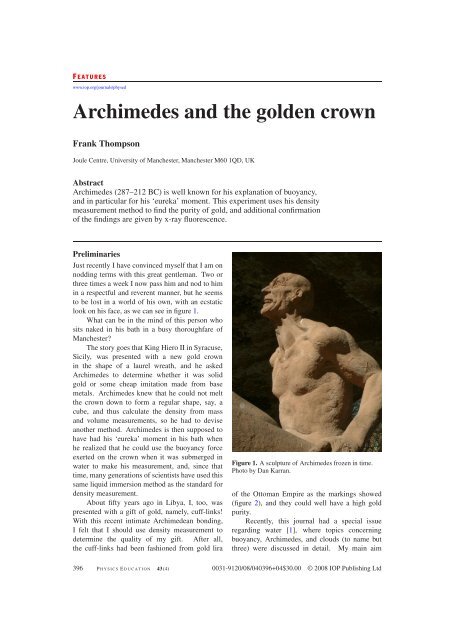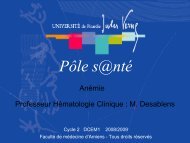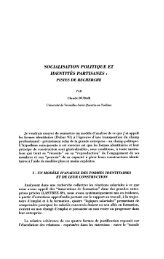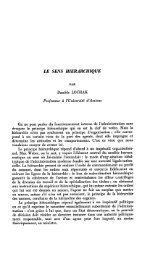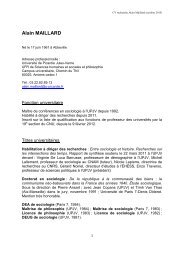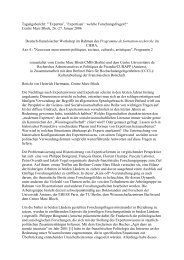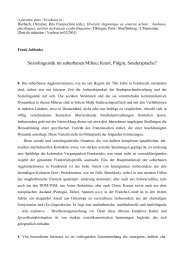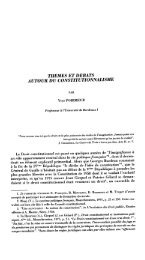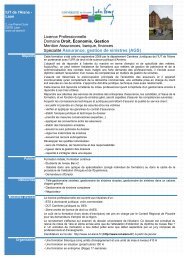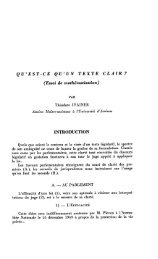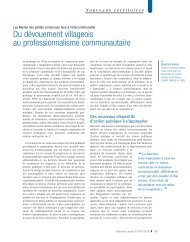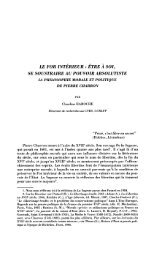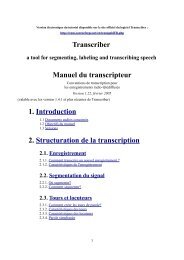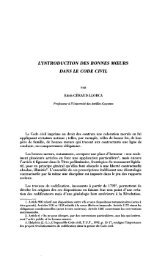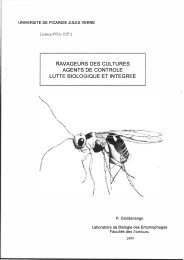Archimedes and the golden crown.pdf
Archimedes and the golden crown.pdf
Archimedes and the golden crown.pdf
Create successful ePaper yourself
Turn your PDF publications into a flip-book with our unique Google optimized e-Paper software.
F EATURES<br />
www.iop.org/journals/physed<br />
<strong>Archimedes</strong> <strong>and</strong> <strong>the</strong> <strong>golden</strong> <strong>crown</strong><br />
Frank Thompson<br />
Joule Centre, University of Manchester, Manchester M60 1QD, UK<br />
Abstract<br />
<strong>Archimedes</strong> (287–212 BC) is well known for his explanation of buoyancy,<br />
<strong>and</strong> in particular for his ‘eureka’ moment. This experiment uses his density<br />
measurement method to find <strong>the</strong> purity of gold, <strong>and</strong> additional confirmation<br />
of <strong>the</strong> findings are given by x-ray fluorescence.<br />
Preliminaries<br />
Just recently I have convinced myself that I am on<br />
nodding terms with this great gentleman. Two or<br />
three times a week I now pass him <strong>and</strong> nod to him<br />
in a respectful <strong>and</strong> reverent manner, but he seems<br />
to be lost in a world of his own, with an ecstatic<br />
look on his face, as we can see in figure 1.<br />
What can be in <strong>the</strong> mind of this person who<br />
sits naked in his bath in a busy thoroughfare of<br />
Manchester?<br />
The story goes that King Hiero II in Syracuse,<br />
Sicily, was presented with a new gold <strong>crown</strong><br />
in <strong>the</strong> shape of a laurel wreath, <strong>and</strong> he asked<br />
<strong>Archimedes</strong> to determine whe<strong>the</strong>r it was solid<br />
gold or some cheap imitation made from base<br />
metals. <strong>Archimedes</strong> knew that he could not melt<br />
<strong>the</strong> <strong>crown</strong> down to form a regular shape, say, a<br />
cube, <strong>and</strong> thus calculate <strong>the</strong> density from mass<br />
<strong>and</strong> volume measurements, so he had to devise<br />
ano<strong>the</strong>r method. <strong>Archimedes</strong> is <strong>the</strong>n supposed to<br />
have had his ‘eureka’ moment in his bath when<br />
he realized that he could use <strong>the</strong> buoyancy force<br />
exerted on <strong>the</strong> <strong>crown</strong> when it was submerged in<br />
water to make his measurement, <strong>and</strong>, since that<br />
time, many generations of scientists have used this<br />
same liquid immersion method as <strong>the</strong> st<strong>and</strong>ard for<br />
density measurement.<br />
About fifty years ago in Libya, I, too, was<br />
presented with a gift of gold, namely, cuff-links!<br />
With this recent intimate Archimedean bonding,<br />
I felt that I should use density measurement to<br />
determine <strong>the</strong> quality of my gift. After all,<br />
<strong>the</strong> cuff-links had been fashioned from gold lira<br />
Figure 1. A sculpture of <strong>Archimedes</strong> frozen in time.<br />
Photo by Dan Karran.<br />
of <strong>the</strong> Ottoman Empire as <strong>the</strong> markings showed<br />
(figure 2), <strong>and</strong> <strong>the</strong>y could well have a high gold<br />
purity.<br />
Recently, this journal had a special issue<br />
regarding water [1], where topics concerning<br />
buoyancy, <strong>Archimedes</strong>, <strong>and</strong> clouds (to name but<br />
three) were discussed in detail. My main aim<br />
396 P HYSICS E DUCATION 43 (4) 0031-9120/08/040396+04$30.00 © 2008 IOP Publishing Ltd
Figure 2. Coins fashioned into cuff-links.<br />
twin cup arrangement<br />
gantry supporting cups<br />
resting on balance pan<br />
liquid providing<br />
bouyancy<br />
support for liquid<br />
resting on balance<br />
casting<br />
Figure 3. The twin cup arrangement for density<br />
measurement.<br />
in this article is to give one of many practical<br />
uses of buoyancy for density measurement, <strong>and</strong> to<br />
undertake a personal quest to determine <strong>the</strong> quality<br />
of gold in a pair of cuff-links.<br />
It is hoped that students partaking of such<br />
an experiment will imbibe some of <strong>the</strong> ecstasy<br />
of <strong>Archimedes</strong>, who initiated this work <strong>and</strong> many<br />
o<strong>the</strong>r ma<strong>the</strong>matical, scientific <strong>and</strong> engineering<br />
discoveries [2].<br />
Experimentation<br />
The usual arrangement for density measurement<br />
by liquid immersion is given in figure 3.<br />
A beaker of liquid is supported by <strong>the</strong> casing<br />
of an electronic balance (in <strong>the</strong> present case, model<br />
PM 460 from Mettler-Toledo Ltd) whereas <strong>the</strong><br />
twin cups have a gantry which rests on <strong>the</strong> balance<br />
pan. An illustration of <strong>the</strong> apparatus is presented<br />
in figure 4, with one of <strong>the</strong> cuff-links in <strong>the</strong> lower<br />
cup <strong>and</strong> <strong>the</strong> o<strong>the</strong>r resting on <strong>the</strong> beaker support.<br />
The balance is tared (zeroed) with <strong>the</strong> cups<br />
being empty. The mass is <strong>the</strong>n recorded for <strong>the</strong><br />
sample in <strong>the</strong> upper cup. The cup stirrup is<br />
removed from <strong>the</strong> gantry, <strong>the</strong> sample is placed in<br />
<strong>the</strong> lower cup, <strong>and</strong> <strong>the</strong> stirrup replaced. Ensuring<br />
that <strong>the</strong> sample is fully covered with liquid <strong>and</strong><br />
<strong>Archimedes</strong> <strong>and</strong> <strong>the</strong> <strong>golden</strong> <strong>crown</strong><br />
Figure 4. A Mettler balance with a twin cup assembly<br />
for density measurement.<br />
that no bubbles are trapped around it, a second<br />
mass is recorded. For <strong>the</strong> case of <strong>the</strong> liquid<br />
being water at a temperature in <strong>the</strong> region of<br />
20 ◦ C, <strong>the</strong> density is simply <strong>the</strong> ratio of <strong>the</strong> initial<br />
measurement to <strong>the</strong> difference in <strong>the</strong> initial <strong>and</strong><br />
final mass measurements. (At a temperature of<br />
16 ◦ C <strong>the</strong> density of water is 999 kg m −3 <strong>and</strong> even<br />
at 22 ◦ C it has only fallen to 998 kg m −3 : i.e.,<br />
very close to 1 g cm −3 [3]). The length of <strong>the</strong><br />
stirrup is not critical, but a compact apparatus is<br />
usually desirable so that <strong>the</strong> stirrup is as short<br />
as is permitted to allow <strong>the</strong> sample to be fully<br />
submerged.<br />
Suitable shielding of <strong>the</strong> balance from<br />
draughts is recommended. For samples that have<br />
a density less than that of <strong>the</strong> liquid providing<br />
buoyancy, a metal weight (anti-float cap) is placed<br />
on <strong>the</strong> bottom cup, <strong>and</strong> <strong>the</strong> initial tare of <strong>the</strong><br />
balance will compensate for this added mass.<br />
Surface tension effects are likely to be small,<br />
as <strong>the</strong> wire forming <strong>the</strong> stirrup has a small<br />
diameter. Also, it will be seen that <strong>the</strong> stirrup is<br />
in <strong>the</strong> same position when <strong>the</strong> two measurements<br />
are made, <strong>and</strong> <strong>the</strong>refore any surface tension effect<br />
will be cancelled out.<br />
July 2008 P HYSICS E DUCATION 397
FThompson<br />
Table 1. Density values, given in units of g cm −3 .<br />
Material Measured density Accepted value [4]<br />
Aluminium 2.70 (±0.03) 2.71<br />
Steel 7.76 (±0.07) 7.80<br />
Cuff-links 17.1 (±0.2) 19.3 (pure gold)<br />
Wood 0.60 (±0.05) 0.70 (soft wood)<br />
Results<br />
Ten readings were taken for each of <strong>the</strong> samples of<br />
aluminium, steel <strong>and</strong> <strong>the</strong> cuff-links, <strong>and</strong> <strong>the</strong> results<br />
are given in table 1. The density of a sample of<br />
wood is also included, though this result must be<br />
counted as, at best, very approximate.<br />
An accuracy of about ±1% was attained with<br />
<strong>the</strong> metal samples, <strong>and</strong> <strong>the</strong>re is good agreement<br />
between <strong>the</strong> measured values of aluminium <strong>and</strong><br />
steel <strong>and</strong> <strong>the</strong> published values. But a major<br />
problem with <strong>the</strong> wood sample was that water<br />
soaked into <strong>the</strong> wood pores, <strong>and</strong> one could see<br />
bubbles of air being ejected from <strong>the</strong> sample.<br />
Some thin coating of varnish would have to be<br />
applied to <strong>the</strong> wood to prevent water ingress if a<br />
serious study was to be undertaken. (Note that <strong>the</strong><br />
balance gives a negative reading for <strong>the</strong> submerged<br />
wood <strong>and</strong> so, on subtraction, <strong>the</strong> two readings have<br />
to be added.)<br />
It is fair to conclude that <strong>the</strong> cuff-links are<br />
not pure gold, but that <strong>the</strong>y must contain an<br />
appreciable amount of gold to have a density value<br />
of 17.1gcm−3 .<br />
Conclusions <strong>and</strong> discussion<br />
In <strong>the</strong> world of jewellery <strong>the</strong> purity of gold is based<br />
on a carat number, with 100% gold being equal<br />
to 24 carats. A gold sample of 22 carats will<br />
have 22 parts gold <strong>and</strong> two parts of one or more<br />
additional metal(s), <strong>and</strong> this scale goes to 10 carat<br />
gold, which would have 10 parts gold <strong>and</strong> 14 parts<br />
of additional metals.<br />
If, say, silver (density 10.5 gcm−3 ) was used<br />
as <strong>the</strong> alloying metal, <strong>the</strong>n an 18 carat gold would<br />
have a density close to 17 g cm−3 (18/24 × 19.3 +<br />
6/24 × 10.5 = 16.9) <strong>and</strong> <strong>the</strong>refore on <strong>the</strong> basis<br />
of this hypo<strong>the</strong>tical notion one could conclude that<br />
<strong>the</strong> cuff-links are 18 carat gold, <strong>and</strong> not very close<br />
to <strong>the</strong> ultimate 24 carats.<br />
(The epilogue shows that <strong>the</strong> alloying metal is<br />
copper ra<strong>the</strong>r than silver.)<br />
Epilogue<br />
Staff at Tech Ed. Systems Ltd kindly offered to<br />
analyse <strong>the</strong> cuff-links using x-ray fluorescence,<br />
with apparatus from Leybold Didactic GmbH, <strong>and</strong><br />
<strong>the</strong>ir response is given below.<br />
‘Some background to <strong>the</strong> method used <strong>and</strong><br />
principles of this analytical technique<br />
The central component of our detector is a Si PIN<br />
photodiode, which is cooled by means of a Peltier<br />
element in order to reduce <strong>the</strong> leakage current. In<br />
<strong>the</strong> Si PIN diode, <strong>the</strong> incoming x-rays produce<br />
electron–hole pairs through interaction with <strong>the</strong><br />
crystal atoms. These pairs are separated in an<br />
electric field <strong>and</strong> <strong>the</strong>n converted into a voltage<br />
pulse. The number of electron pairs <strong>and</strong> <strong>the</strong> pulse<br />
height are proportional to <strong>the</strong> x-ray energy. The<br />
pulse height analysis is carried out with a multichannel<br />
analyser (MCA), which is interfaced to a<br />
PC.<br />
Result<br />
I used a galvanized steel sample to calibrate<br />
<strong>the</strong> detector (FeZn). On analysis your cufflinks<br />
showed <strong>the</strong> presence of only two elements.<br />
Gold, of course, <strong>and</strong> also copper. There seemed<br />
to be no o<strong>the</strong>r metals present. I analysed <strong>the</strong><br />
sample using different geometric configurations<br />
to establish whe<strong>the</strong>r <strong>the</strong> link between <strong>the</strong> coins<br />
contained any o<strong>the</strong>r elements (<strong>the</strong>se were not<br />
minted in <strong>the</strong> Ottoman period). I found no<br />
difference in <strong>the</strong> composition.<br />
It seems <strong>the</strong>n, Frank, that your cuff-links<br />
are 18 carat red gold with a composition of<br />
approximately 75% Au <strong>and</strong> 25% Cu. If you look<br />
at <strong>the</strong> height of <strong>the</strong> Cu (Kα) peak <strong>and</strong> <strong>the</strong> Au (Lα)<br />
peak you will see that <strong>the</strong>y show a ratio of 3:1.<br />
This fits nicely with your findings using <strong>the</strong> density<br />
measurement.’<br />
Acknowledgments<br />
My thanks to Salvatori, Darren <strong>and</strong> Jennie (Tech<br />
Ed. Systems, The Pump House, Rowdens Road,<br />
Wells, Somerset BA5 1TU) for <strong>the</strong>ir helpful<br />
discussions <strong>and</strong> analysis carried out.<br />
Thanks to Dan Karran for his photograph<br />
of <strong>the</strong> statue of <strong>Archimedes</strong>. At present, this<br />
sculpture is suffering from disfigurement.<br />
398 P HYSICS E DUCATION July 2008
Received 25 February 2008, in final form 27 March 2008<br />
doi:10.1088/0031-9120/43/4/007<br />
References<br />
[1] 2007 Phys. Educ. 42 Special issue on water<br />
[2] Zannos S 2005 Life <strong>and</strong> Times of <strong>Archimedes</strong><br />
(Hastings, UK: Mitchell Lane)<br />
[3] Worsnop B L <strong>and</strong> Flint H T 1942 Advanced<br />
Practical Physics 7th edn (London: Methuen<br />
<strong>and</strong> Co Ltd) p 186<br />
<strong>Archimedes</strong> <strong>and</strong> <strong>the</strong> <strong>golden</strong> <strong>crown</strong><br />
[4] Tennent R M 1971 Science Data Book (Edinburgh:<br />
Oliver <strong>and</strong> Boyd)<br />
Dr Thompson joined <strong>the</strong> Physics School<br />
at Manchester Polytechnic after spending<br />
some years working in oil prospecting in<br />
Libya. In <strong>the</strong> late 1990s he took early<br />
retirement, <strong>and</strong> he has done consultancy<br />
work since <strong>the</strong>n. At present, he is<br />
working at <strong>the</strong> Joule Centre, Manchester<br />
University.<br />
July 2008 P HYSICS E DUCATION 399


